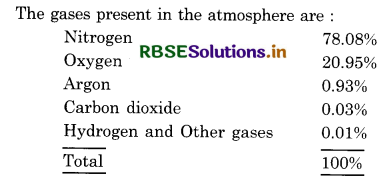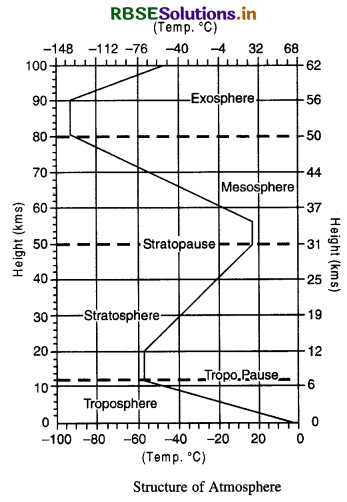RBSE Solutions for Class 11 Geography Chapter 8 Composition and Structure of Atmosphere
Rajasthan Board RBSE Solutions for Class 11 Geography Chapter 8 Composition and Structure of Atmosphere Textbook Exercise Questions and Answers.
Rajasthan Board RBSE Solutions for Class 11 Geography in Hindi Medium & English Medium are part of RBSE Solutions for Class 11. Students can also read RBSE Class 11 Geography Important Questions for exam preparation. Students can also go through RBSE Class 11 Geography Notes to understand and remember the concepts easily.
RBSE Class 11 Geography Solutions Chapter 8 Composition and Structure of Atmosphere
RBSE Class 11 Geography Composition and Structure of Atmosphere Textbook Questions and Answers
Multiple Choice Questions
1. Choose the right answer out of the four alternatives given :
(i) Which one of the following gases constitutes the major portion of the atmosphere?
(a) Oxygen
(b) Nitrogen
(c) Argon
(d) Carbon dioxide
Answer:
(b) Nitrogen.

(ii) Atmospheric layer important for human beings is :
(a) Stratosphere
(b) Mesosphere
(c) Troposphere
(d) Ionosphere
Answer:
(c) Troposphere.
(iii) Sea salt, pollen, ash, smoke soot, fine soil these are associated with :
(a) Gases
(b) Dust particles
(c) Water vapour
(d) Meteors
Answer:
(b) Dust particle.
(iv) Oxygen gas is in negligible quantity at the height of atmosphere :
(a) 90 km
(b) 120 km
(c) 100 km
(d) 150 km
Answer:
(b) 120 km.
(v) Which one of the following gases is transparent to incoming solar radiation and opaque to outgoing terrestrial radiation?
(a) Oxygen
(b) Nitrogen
(c) Helium
(d) Carbon dioxide
Answer:
(d) Carbon dioxide.
Short Answer Type Questions
2. Answer the following questions in about 30 words :
(i) What do you understand by atmosphere?
Answer:
The atmosphere is a vast expanse of air which envelopes the earth all around. It represents the gaseous realm of the earth. It is held to the earth by the force of gravity. It is, thus, an integral part of the earth. It is a very vital part of human existence on earth.
(ii) What are the elements of weather and climate?
Answer:
The atmospheric conditions which make up the weather of place are known as elements of weather. These are :
(a) Temperature
(b) Pressure
(c) Winds
(d) Sunshine
(e) Humidity
(f) Cloudiness
(g) Rainfall
(h) Mist and fog.
The major controls of climate :
The factors which change the climate from place to place are known as the elements of climate.
(a) Latitude
(b) Altitude
(c) Distribution of land and water
(d) pressure
(e) Prevailing winds
(f) Ocean currents
(g) Mountain barriers.
(iii) Describe the composition of atmosphere.
Answer:
See Q. No. 3 (essay-type questions).

(iv) Why is the troposphere the most important of all the layers of the atmosphere?
Answer:
Of all the layers of the atmosphere, troposphere is the most important in climatology due to the following reasons :
(a) This is the weather maing layer of the atmosphere.
(b) All the weather making processes are confined to this layer.
(c) Great contrasts in climate and weather are observed in different areas due to changes of temperature in this layer.
(d) The presence of most of the water vapour in this layer is responsible for condensation, clouds and precipitation.
(e) Dust particles give rise to fog, clouds, smog, etc. in this layer.
(f) Convection currents are confined to this layer for the heating and cooling of the atmosphere.
Essay Type Questions
3. Answer the following questions in about 150 words :
(i) Describe the composition of the atmos¬phere.
Answer:
The atmosphere mainly consists of a mixture of gases in a fairly constant composition. The atmosphere is composed of following three elements :
1. Gases. Nitrogen and Oxygen are the two major gases found in the atmosphere. Nitrogen occupies 78% and Oxygen occupies 21% by volume. The remaining 1% is composed of a number of gases like Hydrogen, Argon, Ozone, Helium, Carbon dioxide. The proportions of the gases remain constant. Oxygen is the most vital gas for sustaining life. Nitrogen and Carbon dioxide are essential for plant life. Oxygen will be negligible at the height of 120 km. Carbon dioxide and water vapour are found upto 90 km.

2. Water Vapour. The amount of water vapour varies from place to place and time to time. Water vapour represents 2% of the air by volume. It is mostly found in the lower layers of the troposphere. About half the water vapour in the air lies below an altitude of 2000 metres. The maximum amount of water vapour is found between 10° and 30° latitudes. It is of primary importance to man. It absorbs insolation. It is the source of all condensation and precipitation on the earth. Water vapour decreases from the equator towards the poles. It is less than 1% in polar area, dry and cold areas of deserts. It preserves the earth radiation and acts as a blanket. It contributes to stability and instability of the air.
3. Dust Particles. The atmosphere holds in suspension many dust particles whose size varies. The major source of dust particles are deserts, lake beds, beaches and dry river beds. These are found in the lower layers of the atmosphere. These affect sun-rays by scattering and absorbing insolation. These are responsible for the formation of clouds, fog and smog. Dust particles act as Hygroscopic nuclei for clouds. These include sea salts, fine soil, smoke soot, ash, pollen, dust, and particles of meteors.
(ii) Draw a suitable diagram for the structure of the atmosphere and label it and describe it.
Answer:
Atmosphere. Atmosphere is a vast expanse of air which envelopes the earth all around. It represents the gaseous realm of the earth. The atmosphere consists of different layers. With the increase in altitude, the atmospheric pressure, density and temperature goes on decreasing. Therefore, on the basis of temperature and density, the atmosphere can be divided into five basic layers.
1. Troposphere :
It is the lowest layer of the atmosphere. Its average height is sixteen kms. Most of the clouds, water vapours, dust particles and atmospheric disturbances are found in this layer. The upper boundary of troposphere is called the Tropopause. The temperature decreases at the ratio of 1°C per 165 metres (normal lapse rate). This layer is important for mankind because it is the weather making layer. Convection currents are confined to this layer. The air is unstable in this zone. This is sometimes called ‘unstable zone.’ Its height is 8 kms near the poles and 18 kms near the equator (average 13 kms).
2. Tropopause :
The upper boundary of troposphere is called tropopause. This layer starts where troposphere ends. Above this, stratosphere starts. It is a zone about 154 km broad. In this transitional zone, the wind and convection currents are absent and the temperature is constant. The air temperature at the tropopause is - 80°C at the equator and - 45°C over the poles.
3. Stratosphere :
This layer lies next to the troposphere. Its average height is 60 kms. It is free from clouds, dust particles, water vapour and convection currents. The temperatures are very low and fairly constant. Its height is higher at the equator than at the poles. Its height is higher in summer than in winter. By the observations from Sputnik, its height has been estimated between 16 to 80 kms. In this zone, the temperature does not increase with altitude. On the other hand the temperature remains constant. The air temperature is
- 80°C over the equator and - 45°C over the poles.


4. Ozonosphere :
Due to concentration of ozone gas it is called ozonosphere. It absorbs ultra violet rays of the sun. It has high temperature due to absorption of these rays. Without the layer of ozone gas, human existence on earth would not have been possible. People would have become blind and their bodies would have been burnt due to ultra violet rays. It is a very hot zone because the temperature increases at the rate of 16°C per km with altitude. It has been observed that this layer is decreasing over Antarctica.
5. Mesosphere :
Mesosphere lies above the stratosphere and extends upto a height of 80 km. Temperature starts increasing with altitude and reaches - 100°C at height of 80 km. The upper limit is called Mesosphere.
6. Ionosphere :
It lies between 60 to 400 km above the Mesosphere. It contains electrically charged particles called ions. Radio waves transmitted from the earth are reflected back to the earth by this layer. Temperature starts increasing.
7. Exosphere :
The upper most layer of the atmosphere above ionosphere is called Exosphere. Very little is known about it. It gradually merges with outer space.

- RBSE Solutions for Class 12 Geography Chapter 11 अंतर्राष्ट्रीय व्यापार
- RBSE Solutions for Class 11 Geography Chapter 1 भारत - स्थिति
- RBSE Solutions for Class 11 Geography Chapter 3 पृथ्वी की आंतरिक संरचना
- RBSE Solutions for Class 8 Our Rajasthan Chapter 5 उद्योग
- RBSE Solutions for Class 11 Geography Chapter 2 संरचना तथा भूआकृति विज्ञान
- RBSE Solutions for Class 11 Geography Chapter 1 भूगोल एक विषय के रूप में
- RBSE Class 11 Geography Important Questions Chapter 7 Natural Hazards and Disasters
- RBSE Class 11 Geography Important Questions in Hindi & English Medium
- RBSE Class 11 Geography Important Questions Chapter 6 Soils
- RBSE Class 11 Geography Important Questions Chapter 5 Natural Vegetation
- RBSE Class 11 Geography Important Questions Chapter 4 Climate